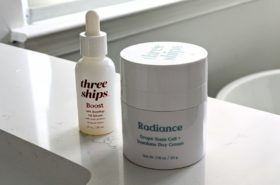
Burdock is a biennial plant, also classified as a common weed, that is most recognized for its stout growth and leaves containing prickly burrs. Due to its ability to grow relatively tall, the burdock plant (scientific name: Arctium lappa) has deep roots that are brownish green in color. The root, leaf and seed are used to make medicine and are sometimes eaten as food. Burdock root extract is typically used in skincare and hair products. This herb is native to Europe and Asia though is naturalized throughout North America. In traditional Chinese medicine, the burdock root was commonly used to treat many illnesses.
Burdock contains chemicals that might have activity against bacteria and inflammation. Burdock root consists of carbohydrates, volatile oils, plant sterols, tannins, and fatty oils which explain the plant’s healing properties. Burdock root has anti-fungal, anti-inflammatory, antioxidant and demulcent effects on the body and skin. In skincare, burdock root is added to many facial steams, cleansers, lotions, toners and salves. The properties of burdock root help effectively treat skin ailments such as acne, eczema and psoriasis.

Burdock root is also used externally to treat painful joints, inflammation and often thought to purify the blood. Burdock root is also added to shampoos, conditioners and hair rinses especially for its beneficial effect on dandruff.
Recent studies have shown that burdock root also contains phenolic acids, quercetin and luteolin, all powerful antioxidants. Various cultures believe eating the leaves or roots of the burdock plant help to cleanse the bloodstream, prevent cancer, to treat high blood pressure and other common illnesses and to keep the body healthy.
Burdock root has also achieved culinary recognition due to its many health benefits when ingested. The plant contains dietary fiber, calcium, potassium, amino acids and is low in calories. Common in Japanese and Korean cuisine, burdock root leaves can be strained for tea, root or leaves added to a soup or drink, or the roots are boiled and braised like a potato.

Sources: Amazing Herbs, Edible Wild Food, Pangea Organics, Web MD, Wikipedia Images: Wikipedia




baileyblush
Love this post, I like to learn about different ingredients! ✌
Kasey Michelle
Thanks, Bailey! I also love learning about different ingredients, their uses and benefits which is why it’s fun to do these posts. 🙂
Read Full Article
Nice website you have there.